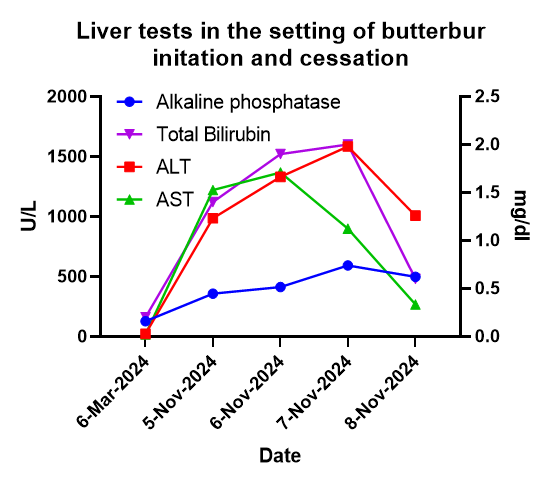Sunday Poster Session
Category: Liver
P1815 - Butterbur Migraine Prophylaxis: A Rare Cause of Liver Injury and Sinusoidal Obstruction Syndrome (SOS) From Pyrrolizidine Alkaloid Toxin
Sunday, October 26, 2025
3:30 PM - 7:00 PM PDT
Location: Exhibit Hall

Taylor Seacor, MD
University of Massachusetts Chan Medical School
Worcester, MA
Presenting Author(s)
Taylor Seacor, MD, Andrew Liu, MD, Garrick Gu, MD, Sankirth Madabhushi, MD, Krunal Patel, MD
University of Massachusetts Chan Medical School, Worcester, MA
Introduction: Pyrrolizidine alkaloids (PA) are a group of phytotoxins that can lead to destruction of hepatic sinusoidal endothelial cells. Reported complications associated with PA ingestion include PA induced liver injury (PA-ILI) and sinusoidal obstruction syndrome (SOS). In Western societies, SOS is typically observed post hematopoietic stem cell transplantation and rarely from PA ingestion. Here we describe a case of butterbur leading to PA-ILI and probable SOS. Butterbur has shown efficacy in migraine prophylaxis with a reported 48% reduction in migraine attack frequency.
Case Description/
Methods: A 52-year-old female with remote polysubstance use disorder, vestibular migraines, hypertension, hyperlipidemia, obesity and major depressive disorder presented with acute onset epigastric and bilateral upper quadrant abdominal pain associated with nausea and vomiting. On presentation, labs were significant for an alkaline phosphatase of 358 U/L, ALT 986 U/L, AST 1221 U/L, direct bilirubin 1.6 mg/dl and total bilirubin 1.4 mg/dl. Total bilirubin peaked at 2.0 mg/dl two days after presentation. Infectious, metabolic, and autoimmune causes were negative, with urine toxicology only positive for benzodiazepines/amphetamines. Abdominal ultrasound and MRCP were notable for cholelithiasis and moderate hepatic steatosis without other significant findings. Further investigation revealed the patient had been started on butterbur by her neurologist ten days prior to presentation. Her mixed hepatocellular/cholestatic liver injury was convincingly secondary to PA-ILI. While there are no established diagnostic criteria for SOS secondary to pyrrolizidine toxin ingestion, the patient met diagnostic criteria for SOS as defined by the Modified Seattle criteria for patients post HSCT given her bilirubin of ≥2 mg/dL and painful hepatomegaly. SOS would also be probable by the 2023 updated European Society for Blood and Marrow Transplantation guidelines. Unfortunately the patient was lost to follow up and repeat labs could not be obtained, although her overall trend reflected improvement prior to discharge (Figure 1).
Discussion: In this case we describe a rare cause of DILI and probable SOS from pyrrolizidine alkaloid toxin found in butterbur. While butterbur supplements are readily available and marketed as “PA free”, chemical analysis of said supplements have found that is not always true. Given potential for significant hepatotoxicity as demonstrated in this case, clinicians should use caution when recommending Butterbur.

Figure: Figure 1: Liver tests in the setting of butterbur initiation and cessation. Total bilirubin shown with mg/dl, AP/ALT/AST using U/L.
Disclosures:
Taylor Seacor indicated no relevant financial relationships.
Andrew Liu indicated no relevant financial relationships.
Garrick Gu indicated no relevant financial relationships.
Sankirth Madabhushi indicated no relevant financial relationships.
Krunal Patel indicated no relevant financial relationships.
Taylor Seacor, MD, Andrew Liu, MD, Garrick Gu, MD, Sankirth Madabhushi, MD, Krunal Patel, MD. P1815 - Butterbur Migraine Prophylaxis: A Rare Cause of Liver Injury and Sinusoidal Obstruction Syndrome (SOS) From Pyrrolizidine Alkaloid Toxin, ACG 2025 Annual Scientific Meeting Abstracts. Phoenix, AZ: American College of Gastroenterology.
University of Massachusetts Chan Medical School, Worcester, MA
Introduction: Pyrrolizidine alkaloids (PA) are a group of phytotoxins that can lead to destruction of hepatic sinusoidal endothelial cells. Reported complications associated with PA ingestion include PA induced liver injury (PA-ILI) and sinusoidal obstruction syndrome (SOS). In Western societies, SOS is typically observed post hematopoietic stem cell transplantation and rarely from PA ingestion. Here we describe a case of butterbur leading to PA-ILI and probable SOS. Butterbur has shown efficacy in migraine prophylaxis with a reported 48% reduction in migraine attack frequency.
Case Description/
Methods: A 52-year-old female with remote polysubstance use disorder, vestibular migraines, hypertension, hyperlipidemia, obesity and major depressive disorder presented with acute onset epigastric and bilateral upper quadrant abdominal pain associated with nausea and vomiting. On presentation, labs were significant for an alkaline phosphatase of 358 U/L, ALT 986 U/L, AST 1221 U/L, direct bilirubin 1.6 mg/dl and total bilirubin 1.4 mg/dl. Total bilirubin peaked at 2.0 mg/dl two days after presentation. Infectious, metabolic, and autoimmune causes were negative, with urine toxicology only positive for benzodiazepines/amphetamines. Abdominal ultrasound and MRCP were notable for cholelithiasis and moderate hepatic steatosis without other significant findings. Further investigation revealed the patient had been started on butterbur by her neurologist ten days prior to presentation. Her mixed hepatocellular/cholestatic liver injury was convincingly secondary to PA-ILI. While there are no established diagnostic criteria for SOS secondary to pyrrolizidine toxin ingestion, the patient met diagnostic criteria for SOS as defined by the Modified Seattle criteria for patients post HSCT given her bilirubin of ≥2 mg/dL and painful hepatomegaly. SOS would also be probable by the 2023 updated European Society for Blood and Marrow Transplantation guidelines. Unfortunately the patient was lost to follow up and repeat labs could not be obtained, although her overall trend reflected improvement prior to discharge (Figure 1).
Discussion: In this case we describe a rare cause of DILI and probable SOS from pyrrolizidine alkaloid toxin found in butterbur. While butterbur supplements are readily available and marketed as “PA free”, chemical analysis of said supplements have found that is not always true. Given potential for significant hepatotoxicity as demonstrated in this case, clinicians should use caution when recommending Butterbur.

Figure: Figure 1: Liver tests in the setting of butterbur initiation and cessation. Total bilirubin shown with mg/dl, AP/ALT/AST using U/L.
Disclosures:
Taylor Seacor indicated no relevant financial relationships.
Andrew Liu indicated no relevant financial relationships.
Garrick Gu indicated no relevant financial relationships.
Sankirth Madabhushi indicated no relevant financial relationships.
Krunal Patel indicated no relevant financial relationships.
Taylor Seacor, MD, Andrew Liu, MD, Garrick Gu, MD, Sankirth Madabhushi, MD, Krunal Patel, MD. P1815 - Butterbur Migraine Prophylaxis: A Rare Cause of Liver Injury and Sinusoidal Obstruction Syndrome (SOS) From Pyrrolizidine Alkaloid Toxin, ACG 2025 Annual Scientific Meeting Abstracts. Phoenix, AZ: American College of Gastroenterology.

